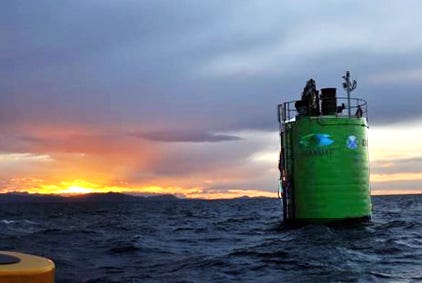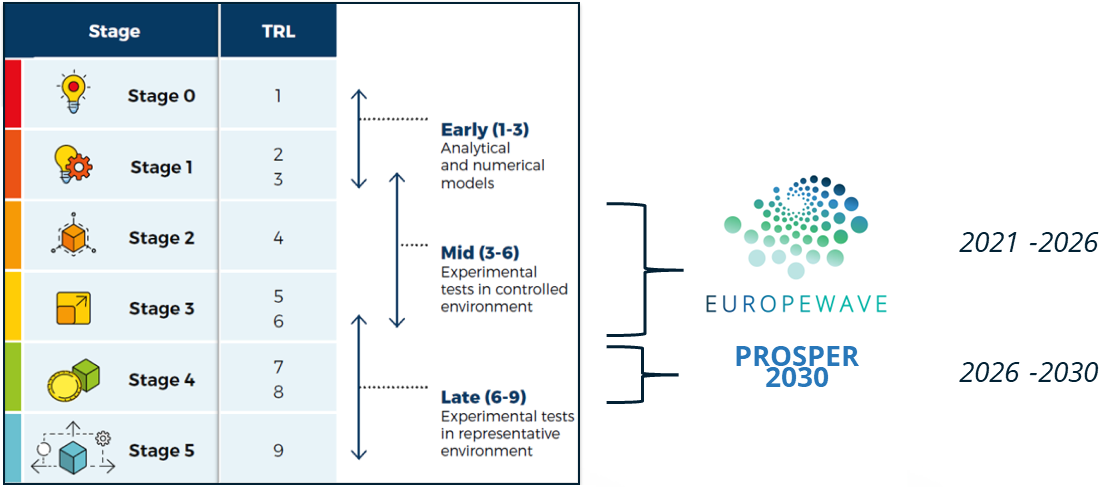My artistic imagining of what wave energy capture devices (at the surface and below) might look like
It is a pretty interesting time as the end of the fossil fuel era looms into view, and the exact shape of the emerging renewable energy era begins to come into focus. It is now clear that solar PV and wind power will become the major vehicles for capturing energy, along with hydro power. Mechanisms for managing a lot of intermittent power to provide 24/7 reliable power are becoming clearer; demand management, interconnectivity (through HVDC cables), storage via batteries (including battery electric vehicles) and pumped hydro all have a role. Whether this is enough, or additional elements will be needed, is an open question. There remains interest in revitalisation of nuclear power, although I’m sceptical.
A wild card is ocean power, which has two aspects, wave power (which addresses energy near the ocean surface created by the wind/ocean interactions) and tidal power (which exploits changes at water/land interfaces or via strong currents). ENEL Green Power thinks that tidal technology is ready for commercialisation, although it has been argued that sea level rise will impact where tidal resources can be exploited.
Wave Power
Wave power continues to show promise but it is still too early to get involved in the heavy lifting, and technology advancements are still dominated by corporate minnows. I commented on wave power developments in 2022. Here I update on recent developments. It remains early days concerning wave power, but there are signs that commercial scale devices will be available soon, largely through European support for this emerging industry.
Small companies don’t have the resources to play in the commercial ocean technology game. Europe has been interested in the potential for clean ocean technology for many years. EuropeWave is a resulting pre-commercial program running from 2021-2025, seeking to fast track a small number of technologies to get things moving. The pre-commercial phase (called EuropeWave) involves ~20 million Euros of national, regional and EU funding. The process started with Wave-Energy Scotland and today has two additional components, Spanish Basque Energy Agency and Ocean Energy Europe.
A core aspect of EuropeWave has been to have public sector and corporate technology developers work together to accelerate progress. Water when angry is very powerful and so the engineering aspects of the technology are non-trivial. The program is about perfecting WEC (Wave Energy Converter) systems to produce electricity under real ocean conditions (not just in safe water tanks). The big goals are European Commission targets of 100 MW ocean energy by 2025 and 1 GW by 2030. If these are achieved, then ocean energy will start to look real.
The EuropeWave project looks for 4 things to make clear that wave power is ready for commercialisation
Performance : demonstrate quantitative evidence of power capture and conversion
Survivability : Show that the technology is robust enough to survive in wild ocean conditions
Availability : Have prototypes which demonstrate feasibility
Affordability : Have numbers to indicate financial feasibility.
The project started with a call for proposals and more than 30 were received. Seven were chosen for Phase 1, which involved a 7 month program of concept development. This was followed by Phase 2, which involved the best 5 projects from Phase 1 to be funded in a design/modelling phase. Finally Phase 3 involves 3 of the best of the 5 Phase 2 participants in an open sea deployment and testing program. The recently announced successful Phase 3 projects are :
1. ACHIEVE (deployment of the CETO prototype), CETO Wave Energy Ireland (wholly owned subsidiary of Carnegie Clean Energy)
CETO is a submersible device. Source EuropeWave
Jonathan Fievez, CEO of Carnegie Clean Energy (ASX:CCE)( US venture market OTCQB:CWGYF), made the point recently that Carnegie has focused its efforts on its CETO Wave technology in Europe (via its wholly owned subsidiary) “because that’s where the support is”. It has worked out well with Carnegie recently becoming the top recipient (of three) under Phase 3 of the EuropeWave program to bring to commercialisation Wave technology. The goal of EuropeWave is for 100 MW installed ocean-derived energy by 2025 and 1 GW by 2030. Since the CETO device being field tested is ~0.4 MW, with the commercial device likely being 1 MW, CETO is unlikely to contribute to a 2025 100 MW target as testing of the 0.4 MW CETO unit will take place over 12 months.
However, the plan is for arrays of CETO devices, so 100MW could come into view at the end of Phase 3.
The Carnegie Clean Energy device CETO is submerged and earlier versions have had a lot of real field testing. This device seems further along the path to commercialisation than the other Phase 3 projects. This is probably why the ACHIEVE project was the top Phase 3 choice.
2. Mocean Energy’s Blue Horizon 250
Blue Horizon is operated at the surface. Source: EuropeWave
Blue Horizon is a hinged raft with forward and aft wave channels. The output of the Blue Horizon is 250 kW and it is targeted for islands and remote communities, along with offgrid opportunities such as oil & gas and aquaculture.
3. IDOM Consulting Engineering Architecture’s MARMOK Atlantic
MARMOK Atlantic operates at the sea surface. Source EuropeWave
The MARMOCK Atlantic harvests energy via the Oscillating Water Column principle. There is a low power grid-connected offshore prototype already in operation. The plan with Phase 3 is to update a range of improvements to the existing prototype.
Next steps beyond EuropeWave
The EuropeWave pre-commercial procurement program is the most visible manifestation of progress in commercial development of wave technology.
There is a parallel grid-connected West Coast US program, PacWave associated with Oregon State University, under development, but putting the infrastructure in place is time consuming. NREL (National Renewable Energy Laboratory (NREL) is involved with supporting emerging companies. There are two sites under construction, one 2km from shore, the other 12 km. There are 7 marine energy companies lined up and the facility will open in 2025. Just as for EuropeWave, PacWave is a confidence boosting program seeking to get some wave technologies to commercialisation.
PROSPER2030
PROSPER 2030 (Procurement-based de-Risking Of wave energy Scale-up for Public fundERs by 2030) is a proposed successor to the current EuropeWave project. It is the next stage of wave energy development and will bring several devices from Stage 3 to Stage 4 of the IEA-OES’s ‘International Evaluation and Guidance Framework for Ocean Energy Technology’.
In practice, this means that PROSPER 2030 will advance wave energy converter systems that have been proven at scale in a real sea environment to a point where they are ready for commercial exploitation.
PROSPER 2030 will be open to all wave developers who meet the eligibility criteria. Developers do NOT need to have participated in EuropeWave, but clearly the Phase 3 EuropeWave winners are likely participants (if successful with Phase 3 of EuropeWave of course).
Just like EuropeWave, it will provide an established structure for public authorities to bring wave energy technology to commercial readiness, based on a competitive procurement procedure, clear performance metrics, and international collaboration.
Image taken from: An International Evaluation and Guidance Framework for Ocean Energy Technology, IEA-OES, 2021, and revised by EuropeWave
Carnegie Clean Energy’s microproject
Carnegie is also developing a microapplication in Western Australia called MoorPower, which is based on elements of its CETO technology, with application for diesel substitution for moored offshore vessels. Partners in this program involve two of Australia’s biggest aquaculture companies Huon Aquaculture and the Tassal Group. There is also funding from the Australian Blue Economy CRC. The MoorPower device has recently been deployed at an offshore test site off Fremantle Australia. The device operates on the surface at a smaller scale than CETO.
Conclusion
As might be apparent from this article, I’m a rusted on supporter of Carnegie Clean Energy, which is one of what I call my “bottom drawer” investments (to be left there until the good times roll). It has been a wild ride. My view of the future of wave technology has been influenced by many different concepts over the years and I’m delighted that Carnegie’s technology is looking good. That said I am not a financial advisor and any thought about investment is yours to choose along with your financial advisor. I hope that my thoughts provide interest and context as you view where wave power might end up fitting in a decarbonized energy system. My guess is that the next step will be a substantial group getting involved with a technology that it thinks is going to work. ENEL is a company to keep an eye on in this regard.








